Is Bacteria the Future of Sustainable Fashion?

By Lynne Lescott
Would you wear a shirt, socks, and shoes made from bacteria? It may sound gross,
but it could become the future of fashion and help reduce waste that contributes to climate change.
Fast Fashion
Traditional clothing production often harms the environment. During mass production, toxic chemicals are used to treat and dye the fibers that become wearable textiles. The chemicals and fiber waste created during the process can enter water supplies near the factory. Footwear and clothing manufacturers also produce emissions and contribute an estimated 8.6 percent of all global greenhouse gas emissions. That’s more than the European Union combined, and the amount has rapidly increased during the past 25 years.
What’s the biggest factor in this? People. Recent studies show that clothing production doubled worldwide between 2000 and 2014 to keep up with consumer demand for trendy fashion items. As fashion preferences change quickly, consumers throw away off-trend clothing more often. Discarded clothing and footwear are usually incinerated or dumped in landfills, where they emit greenhouse gases and leach toxic substances into the soil over hundreds of years—that’s how long it can take for them to decompose.
That’s why fast fashion is a phenomenon that both climate activists and a growing number of clothing manufacturers are trying to end. As experts experiment with new, sustainable processes, bacterial-based clothing production is emerging as one promising solution.
A Potential Fast Fashion Fix
How did bacteria become a sustainable fashion superhero in the first place? It began 200 years ago with the identification of an organic compound called plant cellulose (PC). PC is found in all green plants and its fibers form a strong, biodegradable matrix that strengthens cell walls. People have actually used PC to make textiles and paper products for thousands of years.
About 150 years ago, a scientist discovered that cellulose is also produced by bacteria. Bacterial cellulose (BC) has the same biodegradable properties as PC, yet it’s stronger, more stable, moldable, and has a higher purity. BC can be grown using bacterial cultures.
In a recent collaboration between a well-known fashion brand and a biomaterials company, mango waste was used to nourish and grow BC. Before this partnership the waste would have decayed in a landfill, expelling methane gas. The team used the BC grown from cultures to create sheets of BC fibers. The BC sheets were processed without toxic chemicals and dyed using natural substances before being woven and formed into biodegradeable jackets.
At both ends of the cycle and at each step between, the team focused on creating a sustainable process that could be scaled to produce biodegradeable fashionwear. And BC is the key to the plan.
A Sustainable Fashion Trend
Similar collaborations between scientists and the fashion industry may spur new ways to combine BC’s superhero qualities with sustainable production practices. And that’s a fashion trend worth rooting for.
Discussion Questions
- What other types of waste could be used to grow bacteria?
- What other products could bacterial cellulose be used to make? Make a list.

